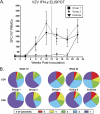Experimental infection of Cynomolgus Macaques (Macaca fascicularis) with human varicella-zoster virus
- PMID: 22258257
- PMCID: PMC3302534
- DOI: 10.1128/JVI.06264-11
Experimental infection of Cynomolgus Macaques (Macaca fascicularis) with human varicella-zoster virus
Abstract
Varicella-zoster virus (VZV) is a member of the alphaherpesvirus family and the causative agent of chickenpox and shingles. To determine the utility of cynomolgus macaques (Macaca fascicularis) as a nonhuman primate model to evaluate VZV-based simian immunodeficiency virus/human immunodeficiency virus (SIV/HIV) vaccines, we experimentally inoculated 10 animals with the parental Oka (Oka-P) strain of VZV derived from MeWo or Telo-RF cells. VZV DNA could be detected in the lungs as late as 4 days postinfection, with replicating virus detected by shell vial culture assay in one case. Infection did not result in any overt clinical symptoms but was characterized by humoral and cell-mediated immunity in a time frame and at a magnitude similar to those observed following VZV vaccination in humans. The cell line source of VZV inoculum influenced both the magnitude and polyfunctionality of cell-mediated immunity. Animals mounted a vigorous anamnestic antibody response following a second inoculation 12 weeks later. Inoculations resulted in transient increases in CD4(+) T-cell activation and proliferation, as well as a sustained increase in CD4(+) T cells coexpressing CCR5 and α4β7 integrin. In contrast to previous failed attempts to successfully utilize attenuated VZV-Oka as an SIV vaccine vector in rhesus macaques due to suboptimal infectivity and cellular immunogenicity, the ability to infect cynomolgus macaques with Oka-P VZV should provide a valuable tool for evaluating VZV-vectored SIV/HIV vaccines.
Figures




Similar articles
-
Abortive intrabronchial infection of rhesus macaques with varicella-zoster virus provides partial protection against simian varicella virus challenge.J Virol. 2015 Feb;89(3):1781-93. doi: 10.1128/JVI.03124-14. Epub 2014 Nov 19. J Virol. 2015. PMID: 25410871 Free PMC article.
-
CD4 T cell immunity is critical for the control of simian varicella virus infection in a nonhuman primate model of VZV infection.PLoS Pathog. 2011 Nov;7(11):e1002367. doi: 10.1371/journal.ppat.1002367. Epub 2011 Nov 10. PLoS Pathog. 2011. PMID: 22102814 Free PMC article.
-
The ORF61 Protein Encoded by Simian Varicella Virus and Varicella-Zoster Virus Inhibits NF-κB Signaling by Interfering with IκBα Degradation.J Virol. 2015 Sep;89(17):8687-700. doi: 10.1128/JVI.01149-15. Epub 2015 Jun 17. J Virol. 2015. PMID: 26085158 Free PMC article.
-
Molecular studies of the Oka varicella vaccine.Expert Rev Vaccines. 2011 Sep;10(9):1321-36. doi: 10.1586/erv.11.93. Expert Rev Vaccines. 2011. PMID: 21919621 Review.
-
Current In Vivo Models of Varicella-Zoster Virus Neurotropism.Viruses. 2019 May 31;11(6):502. doi: 10.3390/v11060502. Viruses. 2019. PMID: 31159224 Free PMC article. Review.
Cited by
-
Development of replication-competent viral vectors for HIV vaccine delivery.Curr Opin HIV AIDS. 2013 Sep;8(5):402-11. doi: 10.1097/COH.0b013e328363d389. Curr Opin HIV AIDS. 2013. PMID: 23925000 Free PMC article. Review.
-
Live attenuated varicella-zoster virus vaccine does not induce HIV target cell activation.J Clin Invest. 2019 Feb 1;129(2):875-886. doi: 10.1172/JCI124473. Epub 2019 Jan 22. J Clin Invest. 2019. PMID: 30511963 Free PMC article. Clinical Trial.
-
Animal models of varicella zoster virus infection.Pathogens. 2013 May 13;2(2):364-82. doi: 10.3390/pathogens2020364. Pathogens. 2013. PMID: 25437040 Free PMC article. Review.
-
Mpox virus Clade IIb infected Cynomolgus macaques via mimic natural infection routes closely resembled human mpox infection.Emerg Microbes Infect. 2024 Dec;13(1):2332669. doi: 10.1080/22221751.2024.2332669. Epub 2024 Mar 29. Emerg Microbes Infect. 2024. PMID: 38494777 Free PMC article.
-
Near-atomic cryo-electron microscopy structures of varicella-zoster virus capsids.Nat Microbiol. 2020 Dec;5(12):1542-1552. doi: 10.1038/s41564-020-0785-y. Epub 2020 Sep 7. Nat Microbiol. 2020. PMID: 32895526 Free PMC article.
References
-
- Arthos J, et al. 2008. HIV-1 envelope protein binds to and signals through integrin α4β7, the gut mucosal homing receptor for peripheral T cells. Nat. Immunol. 9:301–309 - PubMed
-
- Arvin AM. 1999. Chickenpox (varicella), p 96–110 In Wolff MH, Schunemann S, Schmidt A. (ed), Varicella-zoster virus. Molecular biology, pathogenesis and clinical aspects, vol 3 Karger, Basel, Switzerland
-
- Asano Y, et al. 1984. Immunogenicity of wild and attenuated varicella-zoster virus strains in rhesus monkeys. J. Med. Virol. 14:305–312 - PubMed
-
- Bogger-Goren S, et al. 1982. Antibody response to varicella-zoster virus after natural or vaccine-induced infection. J. Infect. Dis. 146:260–265 - PubMed
Publication types
MeSH terms
Substances
LinkOut - more resources
Full Text Sources
Medical
Research Materials

